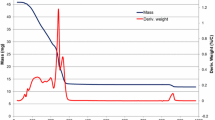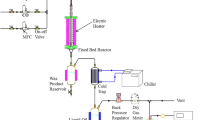Abstract
A novel conversion of cobalt nitrate to cobalt oxide using nitric oxide (Sietsma et al., patent applications WO 2008029177 and WO 2007071899) was utilized to prepare silica- and alumina-supported cobalt catalysts, in order to evaluate the materials for their sensitivity to Fischer–Tropsch synthesis process parameters by kinetics. In the current contribution, TPR-XAFS was used to probe the differences in reducibility and crystallite size resulting from the two procedures over two catalysts having widely different degrees of support interaction with the cobalt oxides. The nitric oxide calcination method resulted in smaller cobalt oxide crystallites compared to the air calcination method, and their increased surface contact with the support resulted in a slower, more broadened, reduction profile. A much more significant impact on crystallite size and reducibility was observed for the more weakly interacting Co/silica catalyst. That is, the already existing strong interaction between alumina and cobalt oxides dictated a small crystallite size upon reduction of the air calcined catalyst, and a measurable but more modest decrease in crystallite size was afforded by the nitric oxide calcination procedure for the alumina supported catalyst.
Graphical Abstract









Similar content being viewed by others
References
Iglesia E (1997) Appl Catal A Gen 161:59
Lok CM (2004) Stud Surf Sci Catal 147:283
Bezemer GL, Bitter JH, Kuipers HP, Oosterbeek H, Holewijn JE, Xu XD, Kapteijn F, van Dillen AJ, de Jong KP (2006) J Am Chem Soc 128:3956
Barbier A, Tuel A, Arcon I, Kodre A, Martin GA (2001) J Catal 200:106
Jacobs G, Das TK, Zhang Y-Q, Li J, Racoillet G, Davis BH (2002) Appl Catal A Gen 233:263
Jacobs G, Ji Y, Davis BH, Cronauer DC, Kropf AJ, Marshall CL (2007) Appl Catal A Gen 333:177
Sietsma JRA, van Dillen AJ, de Jongh PE, de Jong KP (2008) PCT Int Appl WO 2008029177
Sietsma JRA, van Dillen AJ, de Jongh PE, de Jong KP (2007) PCT Int Appl WO 2007071899
Sietsma JRA, Meeldijk JD, den Breejen JP, Versluijs-Helder M, van Dillen AJ, de Jongh PE, de Jong KP (2007) Angew Chem Int Ed 46:4547
van Berge PJ, Barradas S, van de Loosdrecht J, Visagie JL (2001) Erdgas Kohle 117:138
Li J, Zhan X, Zhang Y, Jacobs G, Das TK, Davis BH (2002) Appl Catal A Gen 228:203
Jacobs G, Das TK, Patterson PM, Li J, Sanchez L, Davis BH (2003) Appl Catal A Gen 247:335
Jacobs G, Patterson PM, Das TK, Luo M, Davis BH (2004) Appl Catal A Gen 270:65
van Steen E, Claeys M, Dry ME, van de Loosdrecht J, Viljoen EL, Visagie JL (2005) J Phys Chem B 109:3575
Jacobs G, Ma W, Ji Y, Khalid S, Davis BH (2010) Advances in Fischer–Tropsch synthesis, catalysts and catalysis, Chap. 8. CRC Press/Taylor and Francis Group, Boca Raton, FL, pp 147–164
Jacoby M (2001) Chem Eng News 79:33
Ressler T (1997) J de Physique IV 7:269
Ravel B (2001) J Synchrotron Radiat 8:314
Rehr JJ, Zabinsky SI, Albers RC (1992) Phys Rev Lett 69:3397
Newville M, Ravel B, Haskel D, Stern EA, Yacoby Y (2005) Physica B 208/209:154
Wang W-J, Chen Y-W (1991) Appl Catal 77:223
den Breejen JP, Sietsma JRA, Friedrich H, Bitter JH, de Jong KP (2010) J Catal 270:146
Acknowledgments
The work carried out at the CAER was supported in part by funding from a grant from NASA (#NNX07AB93A), as well as the Commonwealth of Kentucky. Argonne’s research was supported in part by the U.S. Department of Energy (DOE), Office of Fossil Energy, National Energy Technology Laboratory (NETL). The use of the Advanced Photon Source was supported by the U.S. Department of Energy, Office of Science, Office of Basic Energy Sciences, under Contract DE-AC02-06CH11357. MRCAT operations are supported by the Department of Energy and the MRCAT member institutions.
Author information
Authors and Affiliations
Corresponding author
Rights and permissions
About this article
Cite this article
Jacobs, G., Ma, W., Davis, B.H. et al. Fischer–Tropsch Synthesis: TPR-XAFS Analysis of Co/Silica and Co/Alumina Catalysts Comparing a Novel NO Calcination Method with Conventional Air Calcination. Catal Lett 140, 106–115 (2010). https://doi.org/10.1007/s10562-010-0453-6
Received:
Accepted:
Published:
Issue Date:
DOI: https://doi.org/10.1007/s10562-010-0453-6




